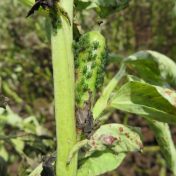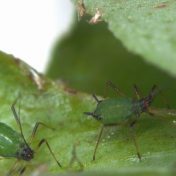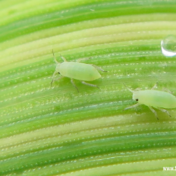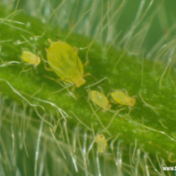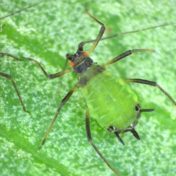History of FBA in Australia Faba bean aphid (FBA; Megoura crassicauda) originated from East Asia. First recorded in Australia in October 2016 in Sydney, FBA was confirmed in northwest NSW (Tamworth and Breeza) in September 2017. The aphid outbreak was controlled using Aphidex (500 g pirimicarb/kg). FBA was not observed again until 2020, where it was recorded on faba bean… Read more »
Faba bean aphid (FBA, Megoura crassicauda) was first noted in Australia on broad beans (Vicia faba L. cv. Coles Early Dwarf) in October 2016 in a Sydney suburb, (Hales et al., 2017). FBA was then recorded in September 2017 at two faba bean trial sites: NSW DPI Tamworth Agricultural Institute (TAI) and Liverpool Plains Field Station Breeza (LPFS Breeza). These… Read more »
Are Russian wheat aphids (RWA) still moving north? No detections of RWA in crops have been received this year, and no detections from outside the already known distribution area. The most northerly detections to date (2018) were from Coonamble and Coonabarabran. We expect RWA to move further north every year and knowing where they are will help you prepare. Now… Read more »
Significant soybean aphid (Aphis glycines) populations have now been observed in many coastal soybean crops. Once the crop approaches late flowering, a spray decision must be made as later aphid infestations can severely delay harvest maturity. Careful monitoring is required to determine if populations are trending upwards to and beyond threshold levels, or if the aphids are being contained by… Read more »
Notes from the meeting at DAF, Monday 21 January 2019 The South Australian Research Institute (SARDI) leads the major GRDC investment in Russian Wheat Aphid (RWA) research in southern Australia. Dr Maarten van Helden and Tom Heddle (SARDI) were in the northern grains region conducting a survey of RWA in the ‘green bridge’ (roadside grasses) during January 2019 (GRDC project… Read more »
Monday 21 January at 8 am Green Room, QDAF Conference Centre, 203 Tor St, Toowoomba. In October 2018, detections of Russian wheat aphid (RWA) were made in Cowra, Forbes, and Condobolin on the Liverpool Plains, and Coonabarabran. NSW DPI Biosecurity reported these detections (read the document here). The map below shows the location of RWA detections in NSW. No detections have… Read more »
Megoura crassicauda has been found in parts of north-east and central New South Wales (Sydney, Tamworth, and Breeza). The species originated in north-east Asia, and is closely related to the vetch aphid (Megoura viciae), found in Europe, Ethiopia and North America. Its host range is mostly limited to Vicia species – vetches, faba or broad beans, and may extend to… Read more »
Russian wheat aphid (RWA) is considered a high priority pest by the grains industry because of its potential to cause significant yield losses in wheat and barley if not well managed. Triticale and rye are also susceptible to crop loss, but oats are considered relatively tolerant. It is inevitable that RWA will establish in the northern grains region, but we… Read more »
Of importance to agronomists is how pest populations are changing over time and the likely impact predators will have on the pest population. Predator and parasitoid activity can be difficult to assess under field conditions, particularly the rate at which beneficials can find pest species. In this research, sentinel prey were used to gauge the level of natural predator and… Read more »
The spread of Russian wheat aphid (RWA) (Diuraphis noxia) in the Northern grains region is considered inevitable. When it might be detected in wheat and barley is less clear as the key drivers of its spread are not well understood in Australia. Wind is likely to play a part in moving winged aphids from south to north. The most northerly… Read more »
